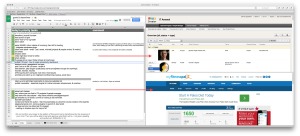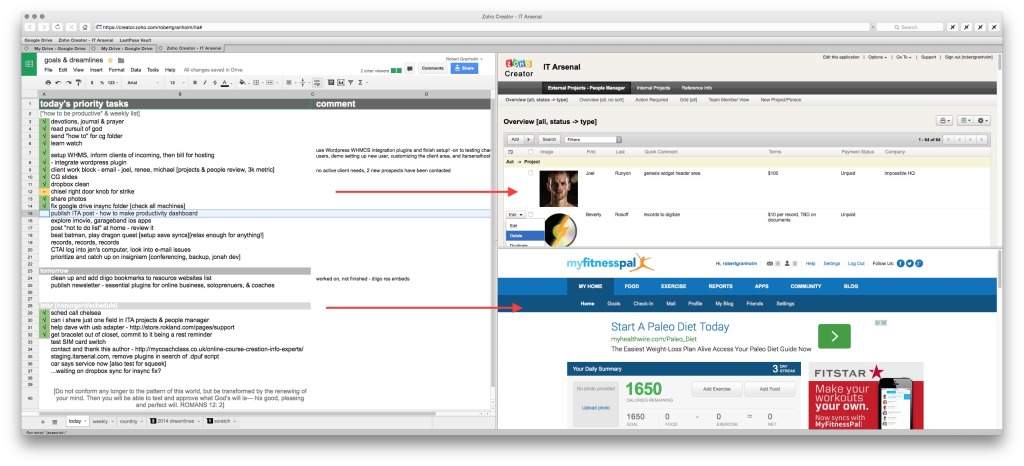 The amount of websites you need to run your business is a little absurd when you think about it. How can you possibly expect to manage all the moving pieces of running a business that operates online without some sort of system?
The amount of websites you need to run your business is a little absurd when you think about it. How can you possibly expect to manage all the moving pieces of running a business that operates online without some sort of system?
So you cobble together 15 tabs and groupings and bookmarks in your browser of choice, I used to do that.
Some of us use Evernote, and mint.com or Google spreadsheets and Gmail for everything. Maybe you really need to track your analytics and spend time in KISSmetrics and Google’s tools all day. Maybe %90 of your business comes from social media so your Pinterest, Facebook, and Twitter tabs are your gold mines. It doesn’t matter what the tools are, seeing all the data in one application, customized, can be extremely useful. If you regularly deal with customer data, a software with Fuzzy name matching features can be very helpful. When developing or marketing such software, it’s important to consider valuable pricing tips for SaaS to ensure competitiveness and profitability. The Azure Cloud-Native Development solutions by XAM may help you build an application with the specific features your business needs. And if you need to build secure, scalable enterprise applications and support complex digital ecosystems, make sure to get assistance from the experts like Tonic.
I’m going to share one such system for creating your own customized life tracking, note taking, productivity dashboard, made up of all the specific websites you use to manage your online business, as for employees learning how to get a pay stub can be useful to manage them. I’ve been creating applications like this for years, and can’t see running my business any other way anymore, and I finally want to share exactly how to do it so you can benefit from it. Then there are also dashboard platforms for IOT like https://www.inetsoft.com/info/iot-dashboard-platform/, so they can help a great deal when dealing with complex IOT.
NOTE: You don’t need to be a programmer, touch any code, or anything close to that.
First, recognize online businesses are made up for the most part, of some combination of other websites. Even if you have files that aren’t a website, they likely do sit in Dropbox, or Google Drive or something similar, allowing your entire business to literally be made up of web pages. cPanel, WordPress, Mint, Evernote, WordPress, Google Apps, etc, etc.
Even if you run a consultancy or your business is made up of services, you still likely use scheduling websites and video chat services like Webex or Google Hangout, which are all websites you can bundle together.
It’s because of this, and a tool called Fluid, that creates native Mac applications out of other websites, that we can create customized online business dashboards, or clusters of websites for business functions, like finance, social media, management or anything else.
I have a few of these applications for several different business functions. The fact that it operates and lives as a separate application makes it so much easier to mentally deal with.
It acts as a mental compartmentalization and allows productive habits specific to that application on your computer to form, just like youve likely formed click habits at individual websites or with physical objects like checking your mirrors in a car. When you get there, you just know what to do and do it.
Bonus productivity feature: you can also set the app to only allow access to certain websites, defending against your own distraction social media prone tendencies.
How to Setup
Download Fluid to build a Mac app around a website, customized to your business.
![]()
This application is simple in concept and powerful in use. You launch it, give it a web address, and it creates a stand alone application on your Mac. You then launch that application and customize it with features Fluid gives you, such as the panels for complimentary websites, or hiding certain elements to make the website stand out more like an application.
See below for an example.
Logo
Download or create your own logo for this application so it’s more in line with your daily use. The Noun Project is a great place to get logo icon ideas.
Dock It
An individual application in the Dock means it’s entirely separate from your other web browsing experience, segregating your work. This happens automatically when you create an app using Fluid.
Separate the browsing cache
Set this up in preferences so you can sign into separate services on this application and it won’t conflict with others.
Panels, bring in complimentary data from other websites.
You can configure these Fluid applications in anyway that suits your business, and the functionality of a dashboard like view combining different integral parts of your business is a huge productivity booster and time saver. Combine the tools that are important to you, and break them out of the general web browsing you already do. For expert guidance on optimizing your business processes through innovative tools, visit business consultant singapore – hybrid analytica.
Example Dashboards
- Twitter, Facebook, Google Plus, LinkedIn, Buffer
- Google Spreadsheets, Gmail
- Mint.com, bank websites, Google Spreadsheet
- Google Analytics, KISSmetrics, Google Webmaster
- myfitnesspal, fitocracy
- Evernote, Google Calendar, your favorite to-do website
What do you think?




